When thinking about how answers come about when dealing with science, one would think that facts are what scientists are looking for. That is a misconception because science deals with evidence not facts.
It could take days or it could take years to find the evidence that makes the product true. There are three main types of evidence. The three main types of evidence that are accepted when trying to figure out a gene’s function are correlative evidence, loss-of-function evidence, and gain-of-function evidence. Correlative evidence is the weakest, but the easiest of the three types.
Correlations are observed between two or more events, and there is an interference that one event causes the other. This provides a starting point for investigations, but one cannot say with certainty that one event causes the other based solely on correlations. With this evidence you see a gene expressed in a tissue. The second type of evidence is the loss-of-function evidence or another name for this is the negative inference evidence.
The one is better than the first but is a little harder. With this evidence you will knock out the gene, and the tissue will fail to form. The third type of evidence it the gain-of-function evidence.This one is the best of all three but it is the hardest also.
With this evidence you will express a gene in an inappropriate tissue and transform it. According to Gilbert, “Here the initiation of the first event causes the second event to happen even in instances where or when neither event usually occurs”. “Science is a communal endeavor, and it is doubtful that any great discovery is the achievement of a single experiment, or of any individual. Correlative, loss-of-function, and gain-of-function evidence must consistently support each other to establish and solidify a conclusion” (Gilbert, 2010).
As stated above, science depends on evidence and not facts to determine if something is true or not. The answer that one is looking for can be in an essay or it can takes years to develop. One must go through a series of failures and accomplishments, the ups and downs, and the many hours that come along with research. “The goal of science is to develop models of the natural world that are reliable, that make predictions about future observations and experiments that turn out to be true.
Science is simply a set of rules of investigation” (Novella, 2008).





